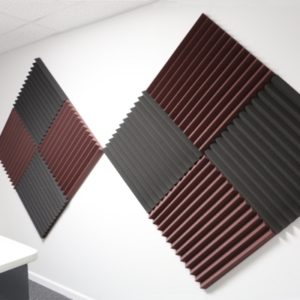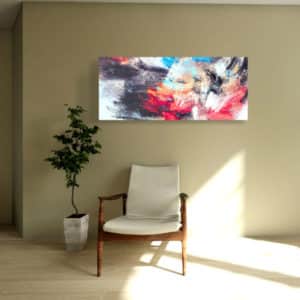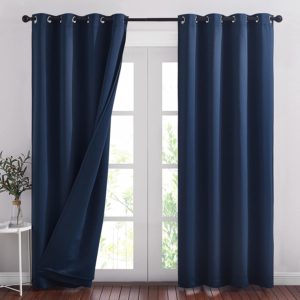For children, echoes are a thing of fascination. For adults, they’re no longer a mystery and they become much less interesting and sometimes unsettling. If you’re a content creator or music producer, room echoes are very likely a thorn in your flesh. Echoes are the shadows of sound. They are caused by the reflection of sound waves off nearby surfaces leading to a repeat of those sound waves, arriving slightly after the direct sound.
Audio is very important to content creators, and most agree that it’s easier to get perfect video than perfect sound. Many factors come into play while you’re recording: the skill of the recorder, microphone selection, and the sound being recorded. One easily ignored factor is the room where the recording is being done. Hollow rooms with hard surfaces, large surface area, no furniture, and high ceilings that reflect sound, produce unwanted echoes and amplify ambient noise.
External noise is another matter that is often out of our control. Working with sound is a delicate process. For example, kids running on the floor above you while you record or your neighbor blasting music at 3 A.M. can create problems that affect your work, if not your process.
While echoes reduce the overall quality of sound, they’re easy to get used to if you’re listening to a single isolated sound or speaker. It gets tricky when you’re listening to a recording, as your brain can reconcile the direct sound and its reflection. However, your audio device lacks that judgment and the result is muffled, noisy audio.
It gets even more tricky listening to a recording of multiple speakers. More speakers mean more echoes from different directions. More echoes mean more sound interference and noise.
In a bid to improve the quality of their sound, many quickly turn to dynamic and condenser microphones or other hardware upgrades. We’ve made such leaps in technology and physics that it’s hard to imagine simple non-technological solutions to complex problems. But there are simple solutions with many benefits! In this guide, we’ll discuss three acoustic treatment products that can help you combat unwanted noise and reduce echo.
If you’ve ever been to music or broadcast studios, you may have noticed some soft out pockets on the walls and in a room corner. Acoustic foam comes in slabs of toothed 2″ inch thick foam material that is placed above hard surfaces to reduce echo from sound interference and reverberation. They do this to break up reflected sound waves and the shape of the room, which reduces the amount of reverb returning to the microphone. This converts the existing sound energy to heat.


They are sold in packs of 12 or 24 slabs of foam. A pack costs around $40 on average, and you may need multiple packs depending on the size of your room or hard surfaces you intend to cover. Acoustic foam panels are made of polyurethane plastic material that provides a soft landing pad for sound waves, which helps disperse or absorb sound. Their toothed surface angles also help to diffuse sound waves when they hit the foam.
Acoustic foams are easy to setup and use. They require zero maintenance or skill to use. All you need is some mounting tape or some kind of easy-to-remove adhesive to hang them. It is important to install them correctly, as after being in place for over 6 months, taking out the foams can create paint peels if you’re not careful.
Some users express concern over acoustic foams ruining the aesthetic of their rooms, but if arranged uniformly and with the right color scheme, they’re rather good-looking. They may look out of place in formal settings, but that seems like a small price to pay in order to remove room echo.
There’s some disagreement over how much acoustic foam reduce echo, but it’s generally agreed that they do very little to keep out external sound. Keeping out external sound (soundproofing) is a different ball game than breaking up internal sound waves. Although they’re advertised as dense, acoustic foam is very light and porous and it does not block sound. Even covering the wall 100% with foam is not going to stop sound from traveling right through the wall.
If your goal is to take some echo and noise out of your personal space, acoustic foam is a good investment at $40. They’re also a good option if you’re uncomfortable with all the sounds bouncing around while you record, or if you have a really sensitive microphone.
If you move around a lot and need to record on the go, foam can be useful if you find yourself in a room with bad acoustics. The more expensive panels are large and inconvenient to carry around, and it’s unrealistic to buy one every time you need to cut out some noise and echo.
However, for rooms with really bad acoustics or work that requires optimal sound, foams don’t cut it. In place of, or in combination with acoustic foam, you may want to employ other means of echo and noise reduction.
Mostly used in recording studios, churches, workplaces, and diners, acoustic panels are sound-absorbing boards that reduce noise and reverberation in a room. Like acoustic foams, panels improve sound quality by reducing the amount of sound waves reflected off the walls. However, they do this by different means.


Unlike acoustic foams that mostly act by breaking up sound waves, acoustic panels are great at sound absorption. This is due to its sound conducting metallic frame and its sound-absorbent core. Most panels have a core made out of fiberglass or recycled materials. Some panels feature a rigid rock mineral wall core, which works the same way as the others, only heavier. Other panels have an air gap within the frame, further contributing to the sound absorption effect.
Acoustic panels are sold in different shapes but are most commonly advertised as vertical rectangles up to 4 feet in length and 1 – 2 feet across. Its metallic frame is usually fully covered by a single-color high-quality fabric that highlights the wall from which it is hung.
Acoustic panels are known for their aesthetic appeal. Their minimalist design makes them a choice pick for formal settings and office environments. They’re sometimes confused for decorations by people unfamiliar with them. Some panel brands have leaned into this by providing artistic coverings for their panels and allowing custom designs specified by users.
The ease of installation varies from brand to brand. Some panels have complex contraptions that require some skill or at least instructions. But the overwhelming majority are easy to use and consist of a picture wire behind the panel’s frame, to be hung on a picture hook on the wall.
Acoustic panels are very effective if placed correctly. Placing panels at known reflection points of a room do a good job of cleaning up the sound. Unfortunately, you don’t just need one, and depending on the size and layout of your studio or workspace, you probably don’t just need three or four. This brings us to its major drawback: cost.
Again, there’s a lot of market variation in the price of acoustic panels, but most brands fall between $130 – $160 for each panel. They’re usually sold in packs of 3 or 4, so they cost about $400 – $600 on average. That’s a lot of money to part with for the pursuit of smoother sound, but in environments where sound clarity is important, it’s an easy investment to make.
You don’t need to cover as large a surface area with these panels as with the acoustic foam. One panel in each reflective wall and one in the ceiling should do the trick. Acoustic panels are designed mostly to absorb mid-level and high frequencies and they do that well. However, they have no impact on sound coming from outside the room.
When it comes to sound management, curtains are victims of their own success. Curtains have always been used for sound control and reducing echoes, but became seen as redundant and have been slowly replaced by modern window glass coverings. However, they’ve crept back into popularity for their soundproofing and sound-absorbing properties.
If you live in a big city or near a busy street, you likely hear a lot of what’s going on outside of your room. This can be annoying when you’re trying to focus, have a conversation, or if you work with sound. Curtains can help to dampen the sound coming from outside, as well as noise and echo within a room. But not just any curtains can do this work.


Costing around $50 – $100 per pair, acoustic curtains (also called insulation curtains) look similar to regular window curtains. The difference is that acoustic curtains are made with denser, nonporous materials. This is why it is able to shut out some outside noise.
They are called insulation curtains because as much as they absorb sound, they also prevent air and heat from escaping or entering through your windows and walls. This makes them suboptimal for the hot months of the year or for those who live in the tropics.
You’ll need a curtain wide and long enough to cover a large portion of the wall and windows for optimal echo removal performance. Heavier curtains are better at absorbing sounds and keeping your space quiet than lighter ones. This is especially true for lower frequencies, such as speech. The rule of thumb for curtains is the thicker the better.
Soundproof curtains on the market are made with a triple-weave fabric, making them denser and more effective at reducing echo. Some brands have a detachable liner that removes the dampening effect if you ever feel the need to.
They’re very flexible aesthetically and you can choose whatever color or style you want.
Curtains tend to gather dust and need to be washed once in a while. Some are not machine washable and that may be inconvenient. Whatever the case, soundproofing curtains are becoming an increasingly popular choice to reduce echo.
There’s a lot of variation as to how effective curtains are at sound absorption. Size, thickness, fabric, and positioning play a role in how well it works. Some users may find this tedious. They’re thick and heavy, making them difficult to move around if you’re a traveler. Although, if you anticipate sound problems it doesn’t hurt to hang a pair.
They can also make living and creative spaces too dark for comfort, compromising your sense of style. This limits the number of rooms where they can be installed unless you are willing to fully sacrifice natural light. Some users may find this useful as it helps if you want full control of your room’s lighting, but it is suboptimal in an office, for example.
If you enjoy a low-light room or your content demands it, curtains can help with lighting and add an extra layer of privacy. Acoustic curtains dampen light exactly the same way they dampen sound.
You may be in an apartment you don’t have authority over or in a hotel room and you don’t want to make any dramatic changes. In that case, acoustic curtains are a great idea as they can easily be taken down and folded when no longer required.
Curtains provide a moderate amount of soundproofing, but nothing short of a full structural overhaul can make a room with bad acoustics soundproof. If you’re interested in a totally soundproof room, you’re going to be unhappy with the results.
If your goal is to have a quiet living room or working space without rogue sounds that bounce around when you’re recording music or dialogue, you’ll need to actively manage and absorb that sound to increase the quality of your recording. Deciding what method to deal with this depends on your budget and what your room layout is like. We would avoid recommending the cheap foam if your work depends on perfect sound as they don’t remove room echo at the same level, but they’re a reasonable buy if you just need to tame the echoing a bit. Curtains provide moderate echo reduction and some soundproofing while remaining affordable and convenient to use furniture. Acoustic panels are expensive, but they deliver smooth sound if properly used and are great for professionals.